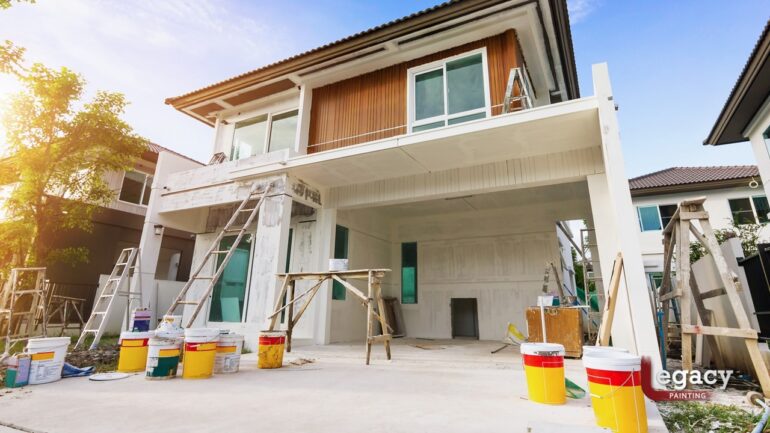A home’s exterior does more than create a first impression—it serves as the first line of defense against the elements. From sunlight and rain to temperature fluctuations, your home’s exterior endures constant exposure to harsh conditions. That’s why exterior painting isn’t just about color; it’s about long-term protection and durability.
A well-executed paint job acts like a weatherproof shield, preventing damage from moisture, UV rays, and environmental pollutants. Achieving that lasting finish requires more than just skill—it’s a careful blend of science, preparation, and high-quality materials.
Experienced professionals like MasterCraft Coatings understand how to combine all these elements to ensure that every layer of paint not only looks beautiful but performs exceptionally well for years to come.
The Role of Preparation in Exterior Painting
Preparation is the single most important factor in determining how long an exterior painting project will last. Even premium paints will fail prematurely if applied to a dirty or unstable surface.
Proper preparation starts with a thorough inspection of the exterior. Painters look for signs of peeling paint, mildew, cracks, or water damage that need to be repaired before new paint is applied. Cleaning the surface—often through pressure washing—removes dirt, dust, and loose debris that could interfere with adhesion.
Once the surface is clean, it’s time to scrape and sand any flaking or rough areas. Applying primer helps the new paint bond more effectively, ensuring even coverage and durability. Skipping these steps might save time in the short term, but it often leads to bubbling, peeling, and discoloration within a year.
Simply put, great results start long before the first stroke of color touches the wall.
Why Weather Conditions Matter
Timing plays a major role in the success of an exterior paint job. Temperature, humidity, and sunlight directly affect how paint dries and adheres.
Most paints perform best when applied between 50°F and 85°F with low humidity. Painting in extreme heat causes paint to dry too quickly, which can lead to visible brush marks or cracking. Conversely, painting in cold or damp conditions slows drying and prevents the paint from curing properly.
Professional painters carefully plan around local weather forecasts to ensure optimal conditions. Choosing the right season for your region can dramatically increase the longevity of your exterior painting project.
The Science of Paint Formulation
Modern paint is a sophisticated mixture of resins, pigments, binders, and additives, all designed to withstand specific environmental stresses. Each ingredient plays a role in how the paint performs over time.
- Resins and binders give paint its adhesion and flexibility.
- Pigments provide color and UV resistance.
- Additives enhance features like mildew resistance, gloss retention, and flow.
For exterior use, formulations are engineered to resist fading, cracking, and peeling caused by sunlight and weather exposure. Acrylic and latex paints are popular for their flexibility and durability, allowing them to expand and contract with temperature changes without losing adhesion.
High-quality products—like those used by MasterCraft Coatings—undergo rigorous testing to ensure consistent color and lasting protection against harsh outdoor elements.
Choosing the Right Paint Finish
The finish of your paint doesn’t just affect appearance; it also influences performance. Common options include:
- Flat or matte finishes: Great for hiding imperfections but less resistant to dirt and moisture.
- Satin or eggshell finishes: Offer a balance between aesthetics and durability, ideal for siding.
- Semi-gloss or gloss finishes: Best for trim and doors, as they resist moisture and are easy to clean.
Selecting the right finish depends on the type of surface and the level of wear it experiences. Professional painters match finishes carefully to achieve both style and function.
The Importance of Color Choice and UV Protection
Color has a direct impact on how your paint ages. Darker shades absorb more heat and tend to fade faster in sunlight, while lighter tones reflect light and remain vibrant longer.
To combat UV degradation, premium paints contain fade-resistant pigments and protective coatings. These advanced formulations block UV rays and maintain color integrity even under intense sunlight.
When planning your exterior painting project, consider your home’s exposure to the sun, surrounding environment, and architectural style. A thoughtful color choice enhances beauty and extends the lifespan of your paint.
Protecting Against Moisture Damage
Moisture is one of the biggest threats to painted surfaces. Without proper sealing, water can seep through cracks or gaps, leading to blistering paint, wood rot, and mold growth.
To prevent this, painters use specialized primers and sealants that repel water and allow the surface to breathe. Caulking around windows, doors, and trim also prevents moisture infiltration.
The key is creating a watertight yet breathable barrier—strong enough to keep water out while allowing vapor to escape. This balance prevents structural damage and ensures your home remains protected year-round.
Surface Materials and Their Unique Needs
Every surface requires a tailored approach. Wood, stucco, brick, and vinyl siding each have their own texture, porosity, and preparation requirements.
- Wood needs sanding, priming, and sealing to protect against moisture and insects.
- Stucco requires flexible coatings that move with the surface to prevent cracking.
- Brick and masonry benefit from breathable paints that prevent trapped moisture.
- Vinyl siding needs specialized paint that adheres to plastic and resists warping.
A professional painter knows how to adjust techniques for each material type. The wrong product or method can lead to premature peeling or structural damage.
Longevity Through Maintenance
Even the most durable paint job requires occasional maintenance. Dirt, mildew, and pollutants gradually accumulate on exterior walls, dulling the finish and wearing down protective layers.
Regular cleaning—typically once or twice a year—helps preserve the paint’s color and texture. Inspecting your home for signs of damage, such as peeling or fading, allows you to address small issues before they spread.
Touch-ups and minor repairs can extend the lifespan of a quality paint job by several years. A well-maintained surface continues to look vibrant and withstand harsh weather far longer than one left untreated.
Environmental Considerations and Eco-Friendly Options
Homeowners today are increasingly mindful of sustainability. Fortunately, modern paints have evolved to include low-VOC (volatile organic compound) and water-based options that reduce environmental impact while maintaining performance.
Low-VOC paints produce fewer odors, dry faster, and contribute to healthier indoor and outdoor air quality. Eco-friendly primers and coatings also minimize pollutants without sacrificing protection or color richness.
By choosing these products, you not only enhance your home but also support a cleaner, greener future.
Final Thoughts: Crafting a Finish That Lasts
Long-lasting exterior painting is both an art and a science. It requires meticulous preparation, the right materials, and expert application tailored to your home’s unique conditions.
A flawless finish isn’t achieved by chance—it’s built on careful planning, premium products, and years of professional experience. With skilled teams like MasterCraft Coatings, homeowners can rest assured that every surface is treated with precision, from the first coat to the final inspection.
Investing in quality today means your home will stay protected, beautiful, and vibrant for years to come—no matter what nature brings your way.






